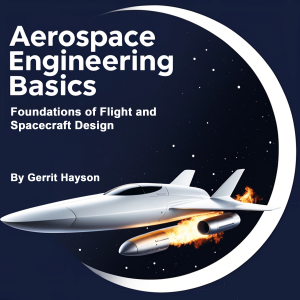

Aerospace Engineering Basics
Gerrit Hayson
This audiobook is narrated by a digital voice.
The dream of human flight has captivated our species for millennia, from the mythological tale of Icarus to Leonardo da Vinci's intricate sketches of flying machines. Today, aerospace engineering transforms these ancient dreams into reality through the precise application of physical principles that govern how objects move through air and space. Understanding these fundamental concepts provides the foundation for all aircraft and spacecraft design, whether we're building a simple glider or planning missions to Mars.
At its core, flight depends on the delicate balance of four primary forces that act upon any aircraft: lift, weight, thrust, and drag. These forces engage in a constant dance throughout every moment of flight, and the aerospace engineer's primary task is to manipulate their relationships to achieve safe, efficient, and controllable flight. Weight, the simplest of these forces to understand, represents the gravitational pull that Earth exerts on the aircraft and everything it carries. This force always acts downward toward the planet's center, and its magnitude depends on the total mass of the aircraft multiplied by gravitational acceleration.
Lift, the force that enables flight, acts perpendicular to the direction of airflow over the wings and opposes weight. The generation of lift involves complex interactions between air molecules and the aircraft's wing surfaces, primarily explained through two complementary principles: Bernoulli's principle and Newton's third law of motion. Bernoulli's principle states that as the speed of a fluid increases, its pressure decreases. Aircraft wings are specifically shaped with curved upper surfaces and flatter lower surfaces, creating what aerodynamicists call an airfoil. As air flows over this airfoil, it must travel a greater distance over the curved upper surface than the flatter lower surface, resulting in higher velocities above the wing and lower pressures compared to the air beneath.
Duration - 50m.
Author - Gerrit Hayson.
Narrator - Digital Voice Matt G.
Published Date - Sunday, 26 January 2025.
Copyright - © 2025 Gerrit Hayson ©.
Location:
United States
Description:
This audiobook is narrated by a digital voice. The dream of human flight has captivated our species for millennia, from the mythological tale of Icarus to Leonardo da Vinci's intricate sketches of flying machines. Today, aerospace engineering transforms these ancient dreams into reality through the precise application of physical principles that govern how objects move through air and space. Understanding these fundamental concepts provides the foundation for all aircraft and spacecraft design, whether we're building a simple glider or planning missions to Mars. At its core, flight depends on the delicate balance of four primary forces that act upon any aircraft: lift, weight, thrust, and drag. These forces engage in a constant dance throughout every moment of flight, and the aerospace engineer's primary task is to manipulate their relationships to achieve safe, efficient, and controllable flight. Weight, the simplest of these forces to understand, represents the gravitational pull that Earth exerts on the aircraft and everything it carries. This force always acts downward toward the planet's center, and its magnitude depends on the total mass of the aircraft multiplied by gravitational acceleration. Lift, the force that enables flight, acts perpendicular to the direction of airflow over the wings and opposes weight. The generation of lift involves complex interactions between air molecules and the aircraft's wing surfaces, primarily explained through two complementary principles: Bernoulli's principle and Newton's third law of motion. Bernoulli's principle states that as the speed of a fluid increases, its pressure decreases. Aircraft wings are specifically shaped with curved upper surfaces and flatter lower surfaces, creating what aerodynamicists call an airfoil. As air flows over this airfoil, it must travel a greater distance over the curved upper surface than the flatter lower surface, resulting in higher velocities above the wing and lower pressures compared to the air beneath. Duration - 50m. Author - Gerrit Hayson. Narrator - Digital Voice Matt G. Published Date - Sunday, 26 January 2025. Copyright - © 2025 Gerrit Hayson ©.
Language:
English
Start
Duration:00:50:50